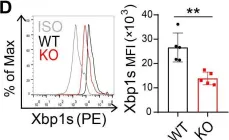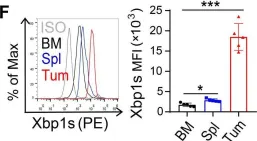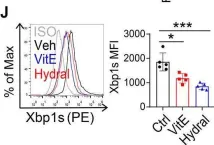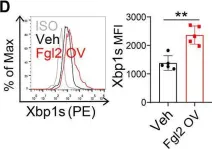Myeloid-derived suppressor cells (MDSCs) are crucial mediators of tumor-associated immune suppression. Targeting the accumulation and activation of MDSCs has been recognized as a promising approach to enhance the effectiveness of immunotherapies for different types of cancer.
The MC38 and B16 tumor-bearing mouse models were established to investigate the role of Fgl2 during tumor progression. Fgl2 and FcγRIIB-deficient mice, adoptive cell transfer, RNA-sequencing and flow cytometry analysis were used to assess the role of Fgl2 on immunosuppressive activity and differentiation of MDSCs.
Here, we show that fibrinogen-like protein 2 (Fgl2) regulates the differentiation and immunosuppressive functions of MDSCs. The absence of Fgl2 leads to an increase in antitumor CD8+ T-cell responses and a decrease in granulocytic MDSC accumulation. The regulation mechanism involves Fgl2 modulating cholesterol metabolism, which promotes the accumulation of MDSCs and immunosuppression through the production of reactive oxygen species and activation of XBP1 signaling. Inhibition of Fgl2 or cholesterol metabolism in MDSCs reduces their immunosuppressive activity and enhances differentiation. Targeting Fgl2 could potentially enhance the therapeutic efficacy of anti-PD-1 antibody in immunotherapy.
These results suggest that Fgl2 plays a role in promoting immune suppression by modulating cholesterol metabolism and targeting Fgl2 combined with PD-1 checkpoint blockade provides a promising therapeutic strategy for antitumor therapy.
© Author(s) (or their employer(s)) 2023. Re-use permitted under CC BY-NC. No commercial re-use. See rights and permissions. Published by BMJ.
Product Citations: 9
In Journal for Immunotherapy of Cancer on 6 December 2023 by Wu, L., Liu, X., et al.
-
FC/FACS
-
Biochemistry and Molecular biology
-
Cancer Research
-
Cell Biology
-
Immunology and Microbiology
Preprint on BioRxiv : the Preprint Server for Biology on 7 July 2023 by Sasaki, I., Fukuda-Ohta, Y., et al.
Cholera toxin (CT), a bacterial exotoxin composed of one A subunit (CTA) and five B subunits (CTB), functions as an immune adjuvant. CTB can induce production of interleukin-1β (IL-1β), a proinflammatory cytokine, in synergy with a lipopolysaccharide (LPS), from resident peritoneal macrophages (RPMs) through the pyrin and NLRP3 inflammasomes. However, how CTB or CT activates these inflammasomes in the macrophages has been unclear. Here, we clarified the roles of IRE1α, an endoplasmic reticulum (ER) stress sensor, in CT-induced IL-1β production from RPMs. In RPMs, CTB is incorporated into ER and induced ER stress responses, depending on GM1, a cell membrane ganglioside. IRE1α-deficient RPMs showed a significant impairment of CT- or CTB-induced IL-1β production, indicating that IRE1α was required for CT- or CTB-induced IL-1β production from RPMs. This study first demonstrates the critical roles of IRE1α in activation of both NLRP3 and pyrin inflammasomes in tissue-resident macrophages. One sentence summary IRE1α is required for NLRP3 and pyrin-mediated IL-1β production
-
FC/FACS
In Nature Communications on 5 May 2023 by Pandit, M., Kil, Y. S., et al.
Programmed cell death protein 1 (PD-1), expressed on tumor-infiltrating T cells, is a T cell exhaustion marker. The mechanisms underlying PD-1 upregulation in CD4 T cells remain unknown. Here we develop nutrient-deprived media and a conditional knockout female mouse model to study the mechanism underlying PD-1 upregulation. Reduced methionine increases PD-1 expression on CD4 T cells. The genetic ablation of SLC43A2 in cancer cells restores methionine metabolism in CD4 T cells, increasing the intracellular levels of S-adenosylmethionine and yielding H3K79me2. Reduced H3K79me2 due to methionine deprivation downregulates AMPK, upregulates PD-1 expression and impairs antitumor immunity in CD4 T cells. Methionine supplementation restores H3K79 methylation and AMPK expression, lowering PD-1 levels. AMPK-deficient CD4 T cells exhibit increased endoplasmic reticulum stress and Xbp1s transcript levels. Our results demonstrate that AMPK is a methionine-dependent regulator of the epigenetic control of PD-1 expression in CD4 T cells, a metabolic checkpoint for CD4 T cell exhaustion.
© 2023. The Author(s).
-
FC/FACS
-
Cancer Research
-
Immunology and Microbiology
TRAPPC1 is essential for the maintenance and differentiation of common myeloid progenitors in mice.
In EMBO Reports on 6 February 2023 by Xu, Y., Zhang, Z., et al.
Myeloid cell development in bone marrow is essential for the maintenance of peripheral immune homeostasis. However, the role of intracellular protein trafficking pathways during myeloid cell differentiation is currently unknown. By mining bioinformatics data, we identify trafficking protein particle complex subunit 1 (TRAPPC1) as continuously upregulated during myeloid cell development. Using inducible ER-TRAPPC1 knockout mice and bone marrow chimeric mouse models, we demonstrate that TRAPPC1 deficiency causes severe monocyte and neutrophil defects, accompanied by a selective decrease in common myeloid progenitors (CMPs) and subsequent cell subsets in bone marrow. TRAPPC1-deleted CMPs differentiate poorly into monocytes and neutrophils in vivo and in vitro, in addition to exhibiting enhanced endoplasmic reticulum stress and apoptosis via a Ca2+ -mitochondria-dependent pathway. Cell cycle arrest and senescence of TRAPPC1-deleted CMPs are mediated by the activation of pancreatic endoplasmic reticulum kinase and the upregulation of cyclin-dependent kinase inhibitor p21. This study reveals the essential role of TRAPPC1 in the maintenance and differentiation of CMPs and highlights the significance of protein processing and trafficking processes in myeloid cell development.
© 2022 The Authors.
Identification of astrocyte regulators by nucleic acid cytometry.
In Nature on 1 February 2023 by Clark, I. C., Wheeler, M. A., et al.
Multiple sclerosis is a chronic inflammatory disease of the central nervous system1. Astrocytes are heterogeneous glial cells that are resident in the central nervous system and participate in the pathogenesis of multiple sclerosis and its model experimental autoimmune encephalomyelitis2,3. However, few unique surface markers are available for the isolation of astrocyte subsets, preventing their analysis and the identification of candidate therapeutic targets; these limitations are further amplified by the rarity of pathogenic astrocytes. Here, to address these challenges, we developed focused interrogation of cells by nucleic acid detection and sequencing (FIND-seq), a high-throughput microfluidic cytometry method that combines encapsulation of cells in droplets, PCR-based detection of target nucleic acids and droplet sorting to enable in-depth transcriptomic analyses of cells of interest at single-cell resolution. We applied FIND-seq to study the regulation of astrocytes characterized by the splicing-driven activation of the transcription factor XBP1, which promotes disease pathology in multiple sclerosis and experimental autoimmune encephalomyelitis4. Using FIND-seq in combination with conditional-knockout mice, in vivo CRISPR-Cas9-driven genetic perturbation studies and bulk and single-cell RNA sequencing analyses of samples from mouse experimental autoimmune encephalomyelitis and humans with multiple sclerosis, we identified a new role for the nuclear receptor NR3C2 and its corepressor NCOR2 in limiting XBP1-driven pathogenic astrocyte responses. In summary, we used FIND-seq to identify a therapeutically targetable mechanism that limits XBP1-driven pathogenic astrocyte responses. FIND-seq enables the investigation of previously inaccessible cells, including rare cell subsets defined by unique gene expression signatures or other nucleic acid markers.
© 2023. The Author(s), under exclusive licence to Springer Nature Limited.
-
FC/FACS
-
Neuroscience
In J Immunother Cancer on 6 December 2023 by Wu, L., Liu, X., et al.
Fig.5.D

-
FC/FACS
-
Collected and cropped from J Immunother Cancer by CiteAb, provided under a CC-BY license
Image 1 of 5
In J Immunother Cancer on 6 December 2023 by Wu, L., Liu, X., et al.
Fig.5.F

-
FC/FACS
-
Collected and cropped from J Immunother Cancer by CiteAb, provided under a CC-BY license
Image 1 of 5
In J Immunother Cancer on 6 December 2023 by Wu, L., Liu, X., et al.
Fig.6.J

-
FC/FACS
-
Collected and cropped from J Immunother Cancer by CiteAb, provided under a CC-BY license
Image 1 of 5
In J Immunother Cancer on 6 December 2023 by Wu, L., Liu, X., et al.
Fig.6.D

-
FC/FACS
-
Collected and cropped from J Immunother Cancer by CiteAb, provided under a CC-BY license
Image 1 of 5
In Genome Med on 24 October 2018 by Pramanik, J., Chen, X., et al.
Fig.1.E

-
FC/FACS
-
Mus musculus (House mouse)
Collected and cropped from Genome Med by CiteAb, provided under a CC-BY license
Image 1 of 5




